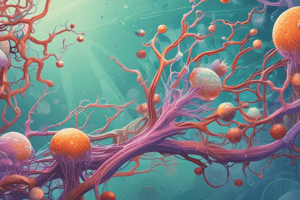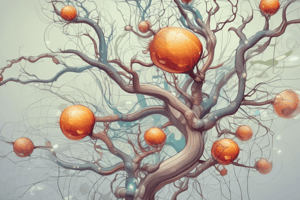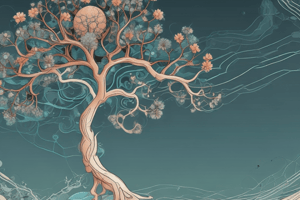Podcast
Questions and Answers
What is the study of the interactions between organisms and their environment?
What is the study of the interactions between organisms and their environment?
What is the jelly-like substance inside a cell?
What is the jelly-like substance inside a cell?
What is the process of creating RNA from DNA?
What is the process of creating RNA from DNA?
What is the random change in gene frequency over time?
What is the random change in gene frequency over time?
Signup and view all the answers
What is the chronological record of life on Earth?
What is the chronological record of life on Earth?
Signup and view all the answers
What are the non-living components of an ecosystem?
What are the non-living components of an ecosystem?
Signup and view all the answers
What is the process by which plants produce energy?
What is the process by which plants produce energy?
Signup and view all the answers
What is the study of the structure, function, and evolution of biological molecules?
What is the study of the structure, function, and evolution of biological molecules?
Signup and view all the answers
Study Notes
Branches of Biology
- Botany: study of plants
- Zoology: study of animals
- Microbiology: study of microorganisms
- Ecology: study of interactions between organisms and their environment
- Biochemistry: study of chemical processes in living organisms
- Molecular Biology: study of biological molecules and their interactions
- Genetics: study of heredity and variation
- Evolutionary Biology: study of evolution and its processes
Cell Biology
- Cell Structure:
- Plasma membrane: outer layer of cell
- Cytoplasm: jelly-like substance inside cell
- Nucleus: contains genetic material
- Mitochondria: generates energy for cell
- Ribosomes: site of protein synthesis
- Cell Functions:
- Metabolism: conversion of energy and nutrients
- Photosynthesis: process by which plants produce energy
- Cell Division: process of cell growth and reproduction
Genetics
- DNA Structure:
- Double helix model
- Composed of nucleotides (A, C, G, and T)
- Gene Expression:
- Transcription: process of creating RNA from DNA
- Translation: process of creating protein from RNA
- Inheritance Patterns:
- Mendelian inheritance: study of how traits are passed down
- Dominant and recessive genes
Evolution
- Mechanisms of Evolution:
- Natural Selection: process of adaptation to environment
- Genetic Drift: random change in gene frequency
- Mutation: change in DNA sequence
- Evidence for Evolution:
- Fossil Record: chronological record of life on Earth
- Comparative Anatomy: study of similarities and differences in body structure
- Molecular Biology: study of similarities and differences in DNA and proteins
Ecosystems
- Components of Ecosystems:
- Biotic factors: living organisms
- Abiotic factors: non-living components (light, temperature, water, etc.)
- Energy Flow:
- Producers: organisms that produce energy through photosynthesis
- Consumers: organisms that obtain energy by consuming other organisms
- Decomposers: organisms that break down dead organic matter
- Interactions:
- Predator-prey relationships
- Symbiotic relationships (mutualism, commensalism, parasitism)
Branches of Biology
- Botany studies plants and their characteristics.
- Zoology focuses on animals, including their structure, behavior, and evolution.
- Microbiology examines microorganisms, including bacteria, viruses, and protists.
- Ecology explores the interactions between organisms and their environment.
- Biochemistry investigates the chemical processes within living organisms.
- Molecular Biology studies biological molecules, such as DNA, proteins, and their interactions.
- Genetics delves into heredity, variation, and the transmission of traits.
- Evolutionary Biology examines the processes and mechanisms of evolution.
Cell Biology
- The plasma membrane is the outer layer of a cell, controlling what enters and leaves.
- Cytoplasm is a jelly-like substance inside the cell where many metabolic processes occur.
- The nucleus contains genetic material in the form of DNA.
- Mitochondria generate energy for the cell through cellular respiration.
- Ribosomes are the site of protein synthesis, where mRNA is translated into proteins.
Cell Functions
- Metabolism is the conversion of energy and nutrients within the cell.
- Photosynthesis is the process by which plants, algae, and some bacteria produce energy from sunlight.
- Cell Division is the process of cell growth and reproduction, resulting in two daughter cells.
Genetics
- DNA is structured as a double helix, composed of nucleotides (A, C, G, and T).
- Transcription is the process of creating RNA from DNA, which then leaves the nucleus.
- Translation is the process of creating protein from RNA, occurring at the ribosomes.
Evolution
- Natural Selection is the process of adaptation to the environment, leading to the survival and reproduction of fittest individuals.
- Genetic Drift is the random change in gene frequency, often occurring in small populations.
- Mutation is a change in DNA sequence, which can result in new traits or increased genetic variation.
Ecosystems
- Biotic factors include all living organisms, from producers to decomposers.
- Abiotic factors are non-living components, such as light, temperature, water, and nutrients.
- Producers, such as plants and algae, produce energy through photosynthesis.
- Consumers, including herbivores and carnivores, obtain energy by consuming other organisms.
- Decomposers, like bacteria and fungi, break down dead organic matter, recycling nutrients.
Studying That Suits You
Use AI to generate personalized quizzes and flashcards to suit your learning preferences.
Description
This quiz covers the different branches of biology, including botany, zoology, and microbiology, as well as cell structure and its components.




